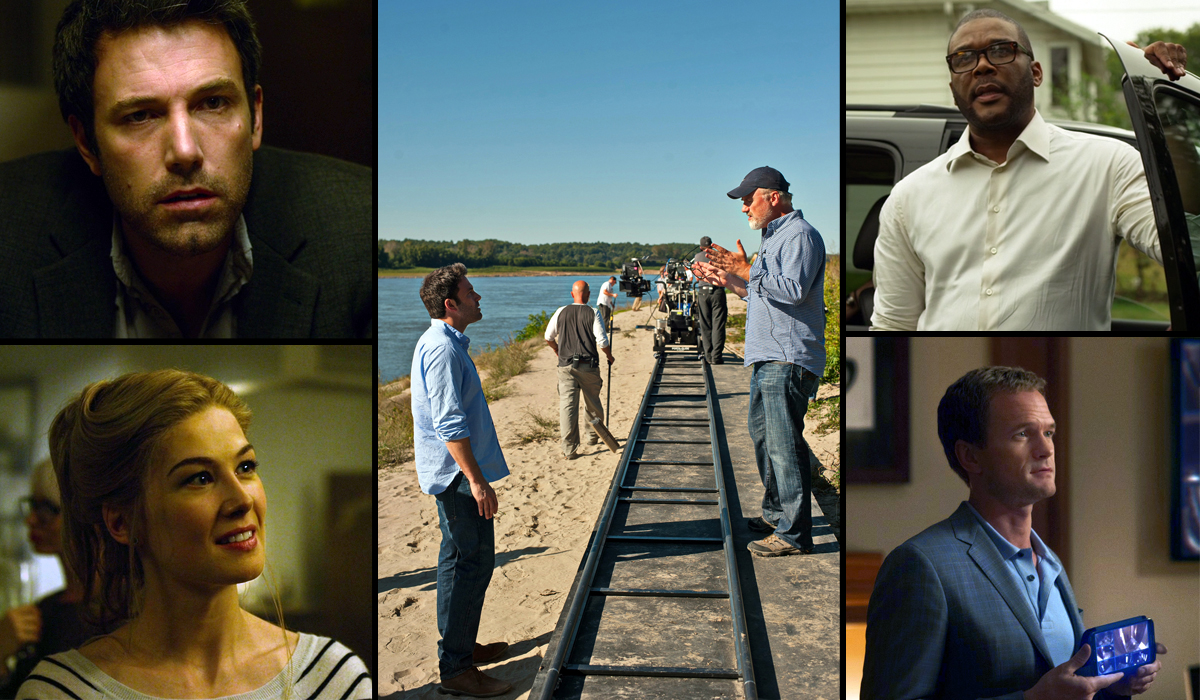Arriving on Blu-ray this week is a fiercely entertaining feature we named one of our favorites of 2014: David Fincher‘s Gone Girl. While the release is light on extras aside from an Amazing Amy book, it does include an engaging feature-length commentary from the director. While we’d recommend listening to it in full, today we’re highlighting some of the best portions from the track.
During the 2.5-hour masterclass of sorts, Fincher touches on the casting of almost every major character, how Jaws, Lolita, Vertigo, Sid & Nancy, Gone with the Wind and Manhattan influenced the film, his trials and tribulations when it came to marketing, when the film gets “really weird,” his “f*ck you” to those criticizing his long takes, how they figured out the ending on set, and much more. Check out what we learned below and, of course, spoilers abound.
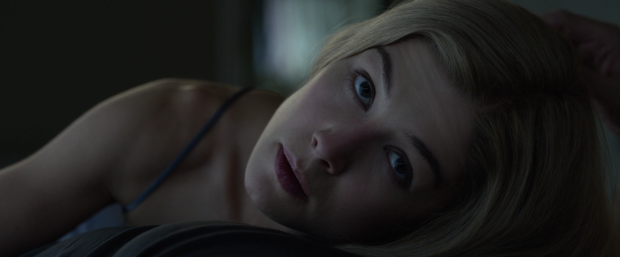
1. Almost every shot of Rosamund Pike has been retouched.
When it comes to the opening shot seen above, Fincher says it “was problematic because we had these long wigs for Amy as she’s meant to be adored. Almost every single shot of her in this movie has been retouched along the wig line in order to fix it. Wig technology has not really changed since Shakespeare and no new procedures or techniques were designed or founded on this film to make them any better than they’ve been. Thank God for digital retouching.”
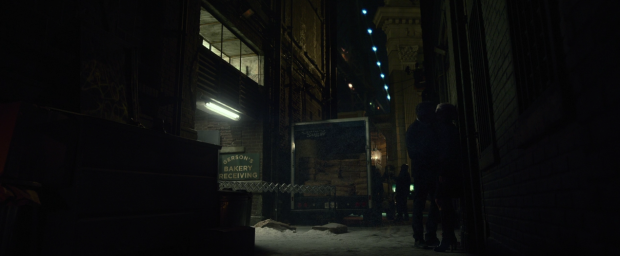
2. The sugar scene was inspired by Sid & Nancy.
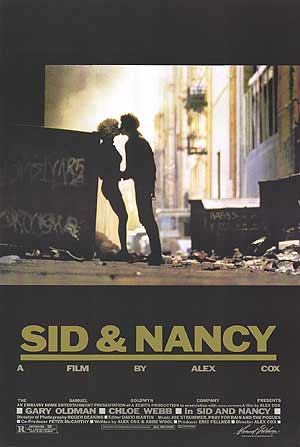 When Nick and Amy first begin dating and walk past the bakery, it’s the only time Fincher has shot on the Universal backlot in his career. He goes on to say, “I love the idea of romance amongst garbage. This reminds me of the Sid & Nancy poster. They’re kissing and garbage cans and paper towels and stuff’s being strewn and flying through the air behind them.”
When Nick and Amy first begin dating and walk past the bakery, it’s the only time Fincher has shot on the Universal backlot in his career. He goes on to say, “I love the idea of romance amongst garbage. This reminds me of the Sid & Nancy poster. They’re kissing and garbage cans and paper towels and stuff’s being strewn and flying through the air behind them.”
3. Casey Wilson is one of the funniest people ever, says Fincher.
“A lot of what the character of Noelle has to do exists in these silent flashbacks where we see this relationship that has cultivated between Amy and Noel,” Fincher says. “A lot of times we’d just bring Casey into a room and would say, ‘OK, you guys are having Chardonnay-fueled girl time in the afternoon and you are discussing Amy’s sex life.” We’d roll and they would just go on these four and five minute tears where they would just talk and talk and talk and it was incredibly Oprah-like. It was extremely heartfelt and Casey Wilson is one of the funniest people that you could ever watch. We’d be in stitches and we’d have the sound completely turned down. I didn’t even know what was being said in the next room because I’d just be looking at her face.”
4. Jaws influenced the formation of the search party.
Discussing the search party, Fincher says, “I love the notion of somebody going missing and needing a search party and having an appeal for public help. I love that it became something to do on this summer day in a small town. The kids are running to get to the common room to hear where they are supposed to go and walk single file and tramp through the underbrush and look for remains. It couldn’t help but remind me a little bit of Jaws.” He adds, “Beyond something taking place on July 4th, beyond the idea of a search party looking for remains, whenever you have 80-feet of dolly track and a walk and talk on the sand, it has to harken to Jaws.”
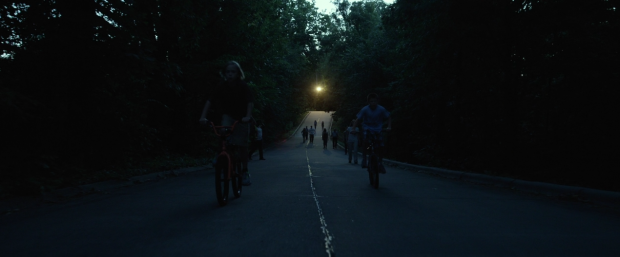
5. Fincher couldn’t initially figure out where to place one of his favorite shots.
“One of the first shots that we did when we were shooting pre-scheduled material, we shot the children riding their bikes,” Fincher says. “It was such a great shot and we were going to use it in the trailer and we didn’t really have a place for it in the narrative. Then finally we said, there’s this nice moment before we go to Margot and Nick where we could use this and so we shoehorned it in there and it’s one of my favorite. Again, it feels like small-town, Middle America.”
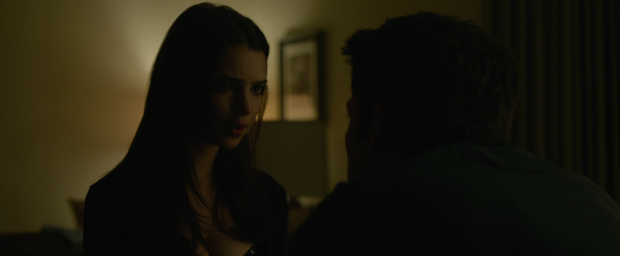
6. Emily Ratajkowski was cast specifically to divide audiences.
“I liked the idea of introducing Andie as this kind of werewolf that comes in the back door and just mauls him,” Fincher says with a laugh. “It’s obviously not something he resists very much. When we were looking for somebody to play Andie it was imperative from my standpoint that we find somebody that could divide the audience immediately. That you could literally take a broad sword and cut right down the center of the theater. Women are going to lean back in their chairs, be disgusted, cross their arms, and go, ‘He is a fucking prick,’ and that men would put their chins on their hands, lean forward, and say, ‘Yeah, but I mean, it’s kind of understandable.’ Emily Ratajkowski does that. She just has that ability. There’s a part of you that says I completely understand why he would make this mistake, but it’s a horrible, horrible transgression and it should be punished.”
7. The Outback line came from Fincher and their experience on set.
Showing the decline of the Dunnes’ marriage, Fincher captures a loveless sex scene, followed by the perfect line, which came from the director. “As he was walking away, I wanted him to say, ‘Let’s go to Outback tonight’ and Rosamund, I want you to — no bullshit — appreciate that as an evening out. We had been spending so much time at the Outback behind the Drury Suites where the crew was staying in Cape Girardeau, that as soon as he tried that take, everybody on the set just started laughing.”
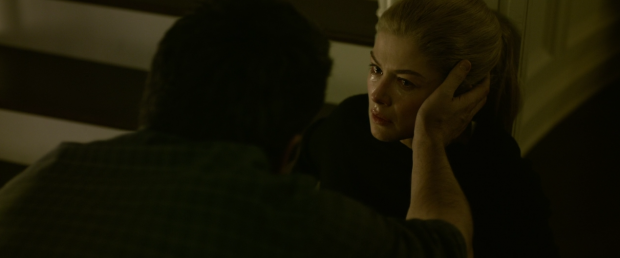
8. The moment where Rosamund Pike recalls a Hitchcock blonde.
The comparisons to the work of Alfred Hitchcock were certainly made around release (including by us) and now Fincher has specified an precise moment of similarity. Right after the Nick knocks Amy over before going out, Fincher says, “The last shot of Rosamund in this sequence really looks like a Hitchcock blonde to me. That really feels like Grace Kelly, the angle, the smudge of tears and snot.”
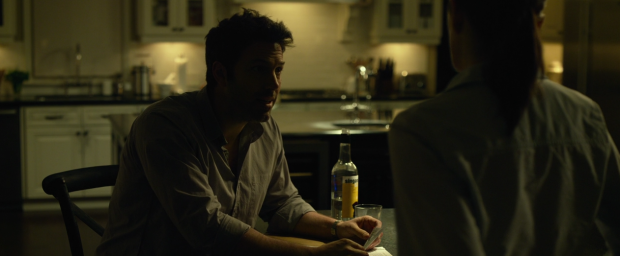
9. How Steven Soderbergh’s Singani 63 made it into the film.
Revealing how Steven Soderbergh got to view the film twice nearly a year ago, Fincher says, “Singani 63 is an alcoholic beverage that is imported by Steven Soderbergh and I gave him a choice as to what scene he wanted his Singani to appear in. He chose a later scene where Rosamund Pike violates herself with a bottle. When she was offered either an exquisite French Chardonnay or this Singani she chose the Chardonnay for actor reasons.” So, instead, we see Soderbergh’s alcohol when Affleck breaks the glass.
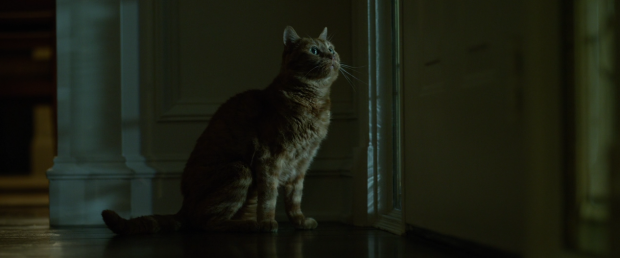
10. The one cast member that didn’t mess up continuity.
One member of the cast that leaves a major impression is the Dunnes’ feline, which Affleck’s character seems to give more attention to than his missing wife. “I love this cat, ” Fincher says. “This cat’s name is Cheeto, because he looks like a Cheeto. Cheeto was not very healthy. I think Cheeto was a little dehydrated. His fur was a little greasy and kind of matted. He didn’t seem to hear very much. I don’t know that he saw very much, but the beauty of Cheeto was wherever you placed Cheeto, that’s where he was going to stay for that day. So continuity with Cheeto was never an issue. If you put Cheeto on the stairs, you can shoot for nine hours and at the end of the day, go, Cheeto’s at the bottom of the stairs and you can pick him up. He was fantastic.”
11. Lolita‘s approach to taboo subject matter influenced the film.
“So, when I was reading the book I got to the point of the twist and I’m reading it. I suddenly become aware that there’s an inevitability to this reveal,” Fincher says. “There’s an inevitability that this movie is nowhere near as simple as just the pregnant wife victim. This speech — the “Cool Girl” speech, which is sort of going to be tacked on bringing the audience up to speed — this is what you’ve really been watching. It’s a very tricky moment. One of the things Gillian and I talked about was initially this movie talks about some ugly things, but has to talk about ugly things in a way that’s amusing and we talked about Lolita.”
“This was a movie in 1962 that’s about a pedophile and yet the movie is not about pedophilia and it’s not a cautionary tale about taking sophisticates into your home and putting them in charge of your daughter,” the director continues. “It’s a movie that has to talk about extremely disturbing things and at a time when you weren’t even allowed to say some of the words the book uses to talk about its subject matter. So they figured out a way to kind of get beyond people’s reticence to even engage and one of the ways they did it was through humor. Certainly when we were talking about Desi Collings we talked a lot about Clare Quilty and how his character doesn’t have to necessarily exist in the real world. He can be a figment of our imagination.”
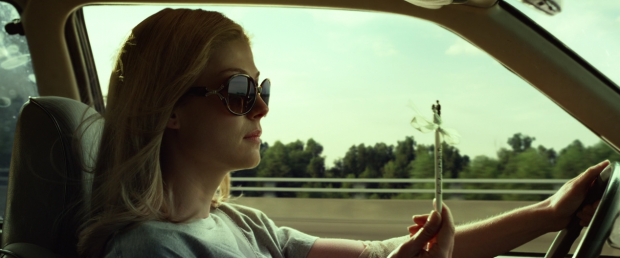
12. Fincher’s dissatisfaction with a Vertigo scene affected Gone Girl.
Speaking about the reveal of Amy’s masterplan halfway through the film, Fincher, says, “This was the moment where we talked about Vertigo. For me, the incredible dissatisfaction in Vertigo is the letter that gets written that explains to Scottie everything that has happened. I felt very much that if we didn’t have a sequence that had kind of a density of information and that didn’t really show you in incredibly compromising terms what went down, it needed to be a sequence as smart as its villain and I think that Gillian wrote that and I think that the density of the information and the thought process behind these ideas really kind of draw you to this character in a way. At the same time she is morally repugnant, she’s also fascinating and I think that’s her saving grace. She’s really fucking interesting.”
13. Fincher had a tough battle with Fox to only use the first 54 minutes of the film in marketing…
“One of the things that took a long time to put together, as far as I was concerned, one of the things that kept me from saying ‘yes’ to this movie for a number of months was my insistence with Jim Gianopulos, the head of Fox, that we can’t use any footage from fade-out where we reveal what’s happened with Amy,” the director says. “We can’t use any of that footage in the trailer. We have to limit ourselves to showing Amy only in flashbacks, because I don’t want to see Ozarks Amy. The one shot that I did allow was the underwater shot because I liked the idea of it setting the stage: did he or did he not kill his wife? Not what happened to his wife, but did he or did he not kill her?”
He continues, “I felt like that footage helped us make that mystery pointed, but it was a really, really interesting and tough marketing restraint, because as much as everybody agrees in theory — ‘yes, we don’t want to give away the twist’ — when push comes to shove and the movie’s not tracking, and people are worried about whether or not anybody is going to show up on Friday night, the first thing that happens is people go, ‘Well, we have this great joke that happens later. She does come back covered in blood. That would be great.’ It took about three months and a lot of conversations with Jim and with Emma Watts at Fox to say, ‘You’re going to have to agree with this. You’re going to have to back the play that if you don’t bury the lede and if you market this movie as here’s a stupid guy and his crazy wife, then there’s no reason to make the movie. You have to give people that enjoyment at least, of finding that out.’ Eventually everybody agreed but it made it really hard to get people into the theater to watch the movie because we were very limited from a teaser to a trailer to television spots, we were limited to the first 54 minutes of footage. We couldn’t use anything else.” He concludes, “The marketing had to be: Did Ben Affleck kill his wife?”
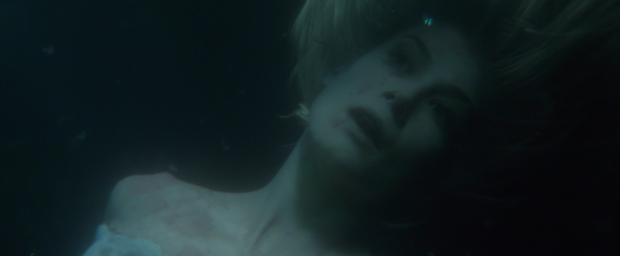
14. …but he wanted some of the marketing to intentionally lie to the audience and make the characters less likable.
As briefly mentioned above, in the trailers, we saw the carefully designed shot of a dead Amy Dunne floating to the depths of the river and because of that, Fincher says that, “the audience was very resistant to liking either of these characters because they thought the blonde chick might die.” He adds, “You have to market a movie in a way that’s going to bring people into the theater. Sometimes you have to promise them things that are beyond the opening scenes of the narrative. When you do that, you kind of fuck up… their minds certainly aren’t blank slates when they come to the theater.”
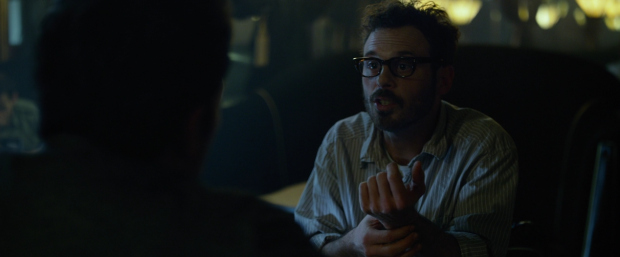
15. Woody Allen’s Manhattan influenced the casting of Scoot McNairy.
“One of my favorite moments in movie history is in Manhattan where Diane Keaton has been talking about this ex-lover of hers who really opened her up sexually to the radical ideas of intimacy,” Fincher says. “The entire time Woody Allen is kind of freaked out about someone who is a professor of hers and finally he meets Wally Shawn and Wally Shawn plays the devastating ex-lover. I love the idea of you are going to meet the person who may or may not have raped Amy and then you meet Scoot [McNairy] and Scoot’s like, ‘Me? Do I look like a rapist?’ I needed someone that you would look at and go, he’s a lot of things but a rapist he is not. He makes half of his case just by showing up in these scene.”
16. Fincher and Affleck fought over what baseball cap the latter would wear.
“There’s a moment described at the end of this scene where Nick Dunne has to reach in his duffel bag or his backpack and get out a baseball cap he’s bought at the airport and he puts it on and walks away in hopes that people don’t recognize him from the television and put two and two together that that’s him — that he’s in their presence.” Fincher jokes, “I really wanted it to be a Yankees cap, but being from Boston and not being very professional as an actor, Ben refused to wear a Yankees cap and we did not come to blows but we had to shut down production for four days as we negotiated with [agent] Patrick Whitesell over what would be the best thing for the movie, what Patrick thought would be the best way to meet the requirements of the production and something that his client could live with, which I thought was entirely unprofessional.”
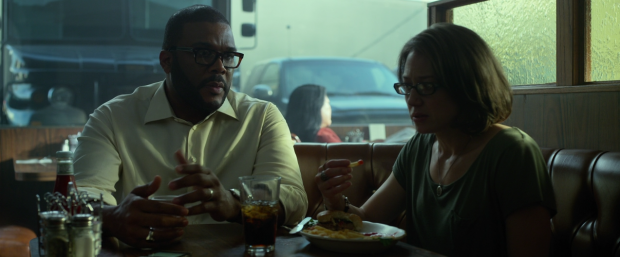
17. Carrie Coon learned about Fincher’s long takes the hard way…
Speaking to his long takes, Fincher says, “Carrie Coon learned the hard way that the last thing you want to do in one of my movies is eat. She probably sucked down at least five-and-a-half pounds of french fries.”
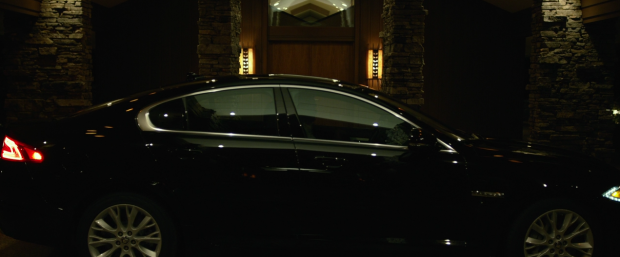
18. …but there’s one shot he got in just two takes.
“So everybody bitches and moans about how many takes [I do],” Fincher says. “People I’ve never even met complain about how many takes I shoot. The take of Neil Patrick Harris parking that Jaguar dead center in the middle of that frame, that was take two. That was take two. It’s in the movie. We walked away after take two. So, please, go fuck yourselves.”
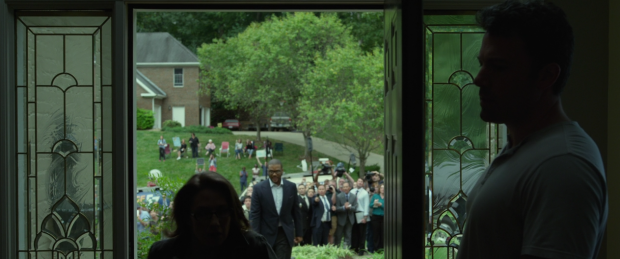
19. How onlookers made their way into the film.
As the media circus in the film continues, Fincher says, “This was something when when we shot in Cape Girardeau on about the third or fourth day at this location, people starting showing up with folding chairs across the street on the lawn and the AD came up to me and said, ‘We will get them. Don’t worry about it. By the time we start shooting we will get all these people out of here.’ I was like, ‘It’s kind of perfect. It’s kind of exactly what you want. What you want is the sense of Gretna Green across the street from Nicole Brown Simpson‘s.”
20. The easy way Fincher controlled the crowd in the casino scene.
For the casino sequence where Amy meets Desi (with the building’s exterior constructed by visual effects as seen above), Fincher perfectly knew why he didn’t have to worry about the crowd, saying, “This is the one scene we shot where we didn’t have control of the extras because we were shooting in a working casino and it worked perfectly. It was great.” He adds, “The great news about shooting in a casino is that if you don’t have control of the background, the last thing you need to worry about is people looking in the lens because they are all watching their money and so their interest is elsewhere. They were very easy to control. We just kept giving them chips.”
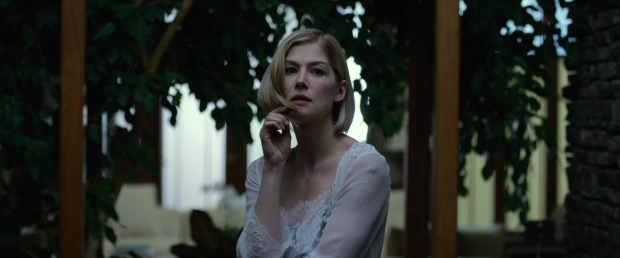
21. Where the movie gets “really weird,” according to Fincher.
Right after Nick is put under arrest, Fincher says there’s another major shift, admitting, “Now the movie gets really weird. Now Rock Hudson and Doris Day are in their Frank Lloyd Wright home in the trees around a lake somewhere in Missouri and it was never expected that this be particularly realistic. It’s incredibly hyperbolic and its going to get weirder and what I love about this is how these guys took to [it]. This is such a weird thing to say: ‘OK, you are in lingerie and you’ve got to go to the office and she’s going to tell you a story about how much she hates her ex-husband and how you stand apart from him and people like him.’ He does that little thing where she talks about Proust and he does this little, ‘What can I say?’ It’s incredibly funny to me and I love that she’s trying to build a case, a new document through the video diary, a new entry into her diary of victimization. And so she has to mess up his hair and untuck his shirt and get him to bleed and she does this and then, of course, she offer ups, ‘That’s how the kids are wearing it’ and he has no idea what she’s talking about but she sends him on his way. It’s sort of naughty and sexy and promises something else in the future, the extent to which he does not truly understand.”
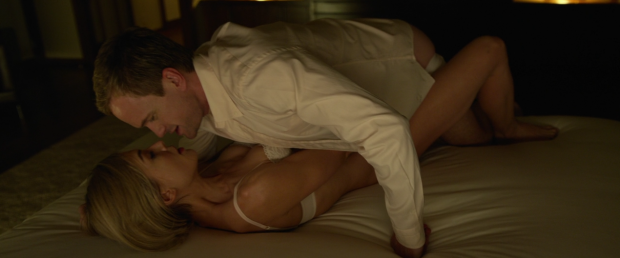
22. David Fincher on that scene.
Speaking to one of the film’s most memorably grotesque sequences, Fincher says, “It’s not about two people enjoying eachother. It’s about one person getting their needs met while another person has to get half of their needs met. It was a particularly complex scene to shoot — not so much for the activity, but for the clean-up. We shot for two days. We had 36 changes of wardrobe, 36 changes of bedding, 36 pillows. The reason why, obviously, is it’s messy. The idea of somebody being slaughtered like a lamb in the middle of coitus, it was dirty work, but somebody had to do it.”
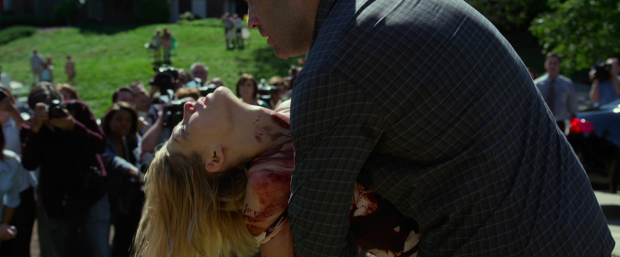
23. Gone with the Wind influenced Nick and Amy’s bloody reunion.
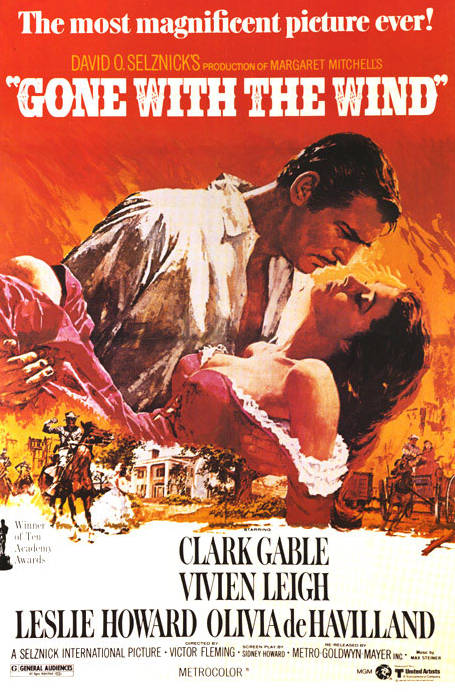 “The day that we shot this sequence I think was the day that the cast, well at least Ben and Rosamund finally realized that they were dealing with somebody that was a little unhinged,” Fincher says about his approach. “We took about an hour-and-a-half to get the continuity of the blood on Rosamund and that it could flake off and look like she had been bloody all night and she showed up on the set and I said, ‘OK, then she comes forward and she falls into your arms and then I want the poster for Gone with the Wind. I want her to fall.’ After you say, ‘You fucking bitch,’ she falls away from you and gives the press the photo of their careers. It has to be People magazine fodder for the next 15 years.”
“The day that we shot this sequence I think was the day that the cast, well at least Ben and Rosamund finally realized that they were dealing with somebody that was a little unhinged,” Fincher says about his approach. “We took about an hour-and-a-half to get the continuity of the blood on Rosamund and that it could flake off and look like she had been bloody all night and she showed up on the set and I said, ‘OK, then she comes forward and she falls into your arms and then I want the poster for Gone with the Wind. I want her to fall.’ After you say, ‘You fucking bitch,’ she falls away from you and gives the press the photo of their careers. It has to be People magazine fodder for the next 15 years.”
Fincher adds, “It was the moment where we had the crane set up, we were ready, we had the 21mm lens to be on the over-the-shoulder and she drops and we see everybody go crazy and then the camera shoots up into the air and when I showed that to Ben and Rosamund thats when they were like, ‘What is this movie? What is going on?’ It was a very enjoyable moment because they finally realized how unhinged the third act of this movie was going to be. It was definitely one of those moments where you thought if I show this footage you will understand exactly what’s going on in my head.”
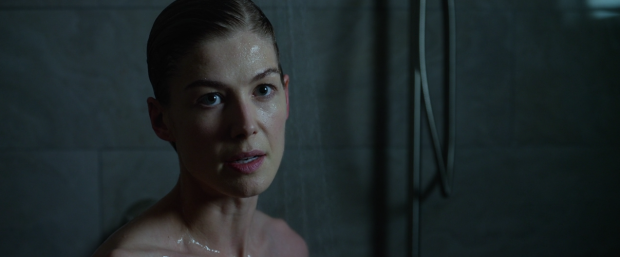
24. The scene in which the looping performances were better than on set, and Fincher’s favorite shot of Pike.
“The whole reason this scene takes place in a shower is so that the character Nick Dunne can’t be recorded saying any of these lines and that none of the things Amy will say to Nick Dunne could be recorded by any outside parties,” Fincher says,” which of course means the entire scene needs to be looped, because indeed being in the shower yields dialogue tracks that are wholly unsuitable. I feel like the looping on this, the performances of it, are as good or better than anything that they gave on the day.” Fincher also notes “his favorite shot of Rosamund ever,” which is pictured above. “You see she is strong, she is stunning, and she is nuts.”
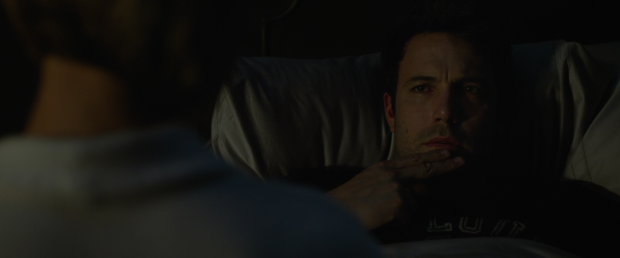
25. Fincher teased Affleck about his chin and how it led to his casting as Batman.
“I don’t know where this idea of a villainous chin came in,” Fincher says in reference to the recurring gesture between the Dunnes (and as mistress). “But we teased Ben mercilessly during the making of the movie that he said yes to this movie and then immediately got on the phone to his agent and said, ‘OK, I’m doing a villainous chin role. You have to find me a heroic chin role and that’s how Batman came about.”
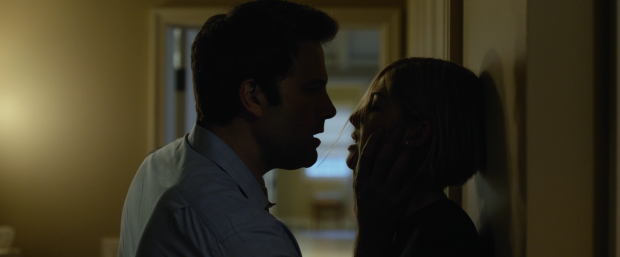
26. The ending of the film was figured out on set.
Speaking on the divisive finale, Fincher says, “This is a scene that we kind of Frankenstein-ed from two or three other scenes that were written for this moment. We were rehearsing on the day and kind of sent the crew out as we were trying to figure out what the thesis scene was going to be. We needed a scene where he gets trapped, but that they also have a discussion about what all this is — what it all means. So Ben grabbed Rosamund and [said], ‘I’d just call her a cunt. I don’t know any other way.’ I said, ‘OK, so you would do that.’ Everybody [said], ‘Oh, no. You can’t. You can not use that word. You can not use that word.’ I said, ‘Well, what if Rosamund takes the word back? What if she says, ‘Yeah, OK. That word has no power over me. Let me tell you what, if that’s how little you think of me that you would use that word, let me remind you that this is who I am. I’m that person, yes. But if you look at your life, you were never more alive and never better than when you were trying to be somebody that this person would like.'”
Fincher adds, “And then it pushes him into this kind of honesty where he says, ‘What is it about this what you would even want?’ He rattled that off. Ben, when he gets on a roll, he can get angry and he went on this roll about ‘Yes, we loved each other, but look what’s happened, look where we are now, look what it is,’ and Rosamund just said, ‘Well that’s marriage.’ And I said, ‘Hm, maybe not that reading, but that’s a pretty powerful idea that that’s what it’s all about. It is about knowing your limitations and knowing the things that you are attracted to and knowing that they are unhealthy to you. It certainly illuminated for me what this relationship is about and why it was as poisonous and dramatic as it had become.”
Gone Girl is now available on Blu-ray. All images courtesy of 20th Century Fox.
Listen to our discussion of the film, 7 similar films, and Fincher’s manipulation of trust.

